Business and Business Environment Analysis: Tesco Plc Report
VerifiedAdded on 2020/11/12
|24
|4962
|154
Report
AI Summary
This report provides an in-depth analysis of the business environment, focusing primarily on Tesco Plc, a major UK-based supermarket chain. The report begins by defining and differentiating between public, private, and voluntary organizations, using the National Audit Office and Cancer Research UK as examples alongside Tesco. It explores the aims, purposes, legal structures, size, and scope of each organizational type. The report then delves into Tesco's operations, examining the interrelationship between various organizational functions such as HR, marketing, finance, and IT, and their collective role in achieving organizational objectives. Furthermore, the report includes a SWOT analysis of Tesco Plc, assessing its strengths, weaknesses, opportunities, and threats. It also incorporates a PESTLE analysis to evaluate the impact of political, economic, social, technological, legal, and environmental factors on Tesco's business operations. The report concludes with a summary of findings and a list of references.
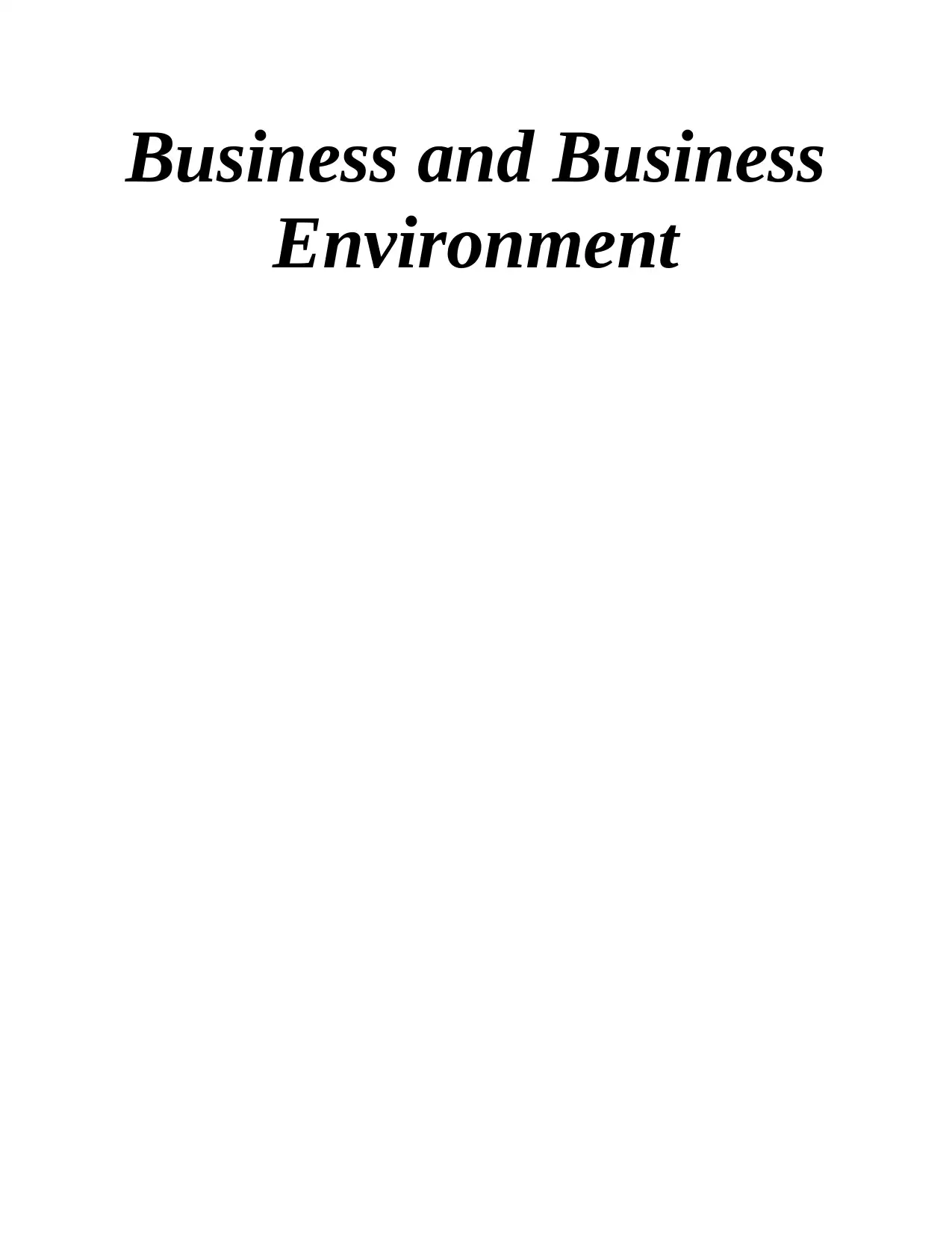
Business and Business
Environment
Environment
Paraphrase This Document
Need a fresh take? Get an instant paraphrase of this document with our AI Paraphraser
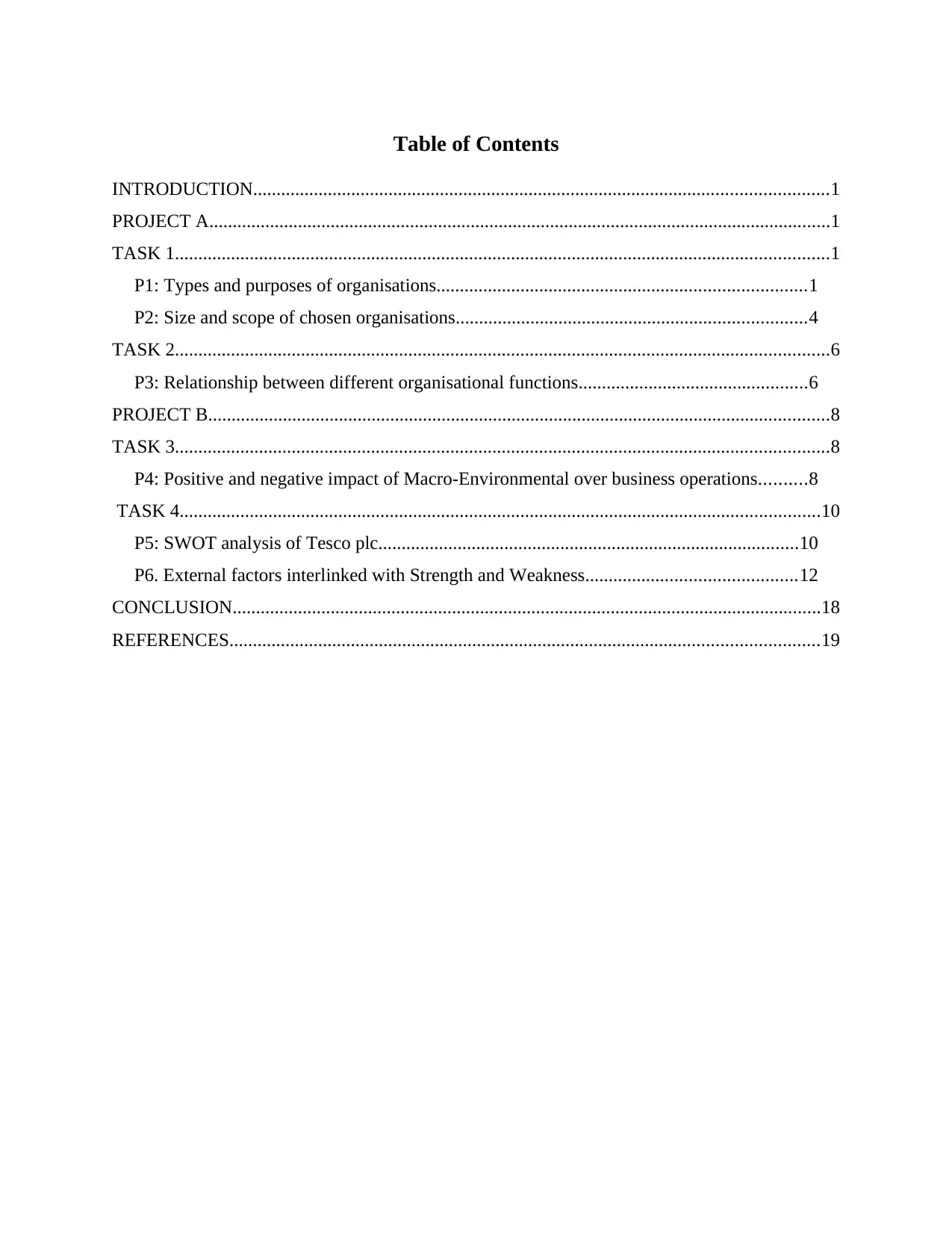
Table of Contents
INTRODUCTION...........................................................................................................................1
PROJECT A.....................................................................................................................................1
TASK 1............................................................................................................................................1
P1: Types and purposes of organisations...............................................................................1
P2: Size and scope of chosen organisations...........................................................................4
TASK 2............................................................................................................................................6
P3: Relationship between different organisational functions.................................................6
PROJECT B.....................................................................................................................................8
TASK 3............................................................................................................................................8
P4: Positive and negative impact of Macro-Environmental over business operations..........8
TASK 4.........................................................................................................................................10
P5: SWOT analysis of Tesco plc..........................................................................................10
P6. External factors interlinked with Strength and Weakness.............................................12
CONCLUSION..............................................................................................................................18
REFERENCES..............................................................................................................................19
INTRODUCTION...........................................................................................................................1
PROJECT A.....................................................................................................................................1
TASK 1............................................................................................................................................1
P1: Types and purposes of organisations...............................................................................1
P2: Size and scope of chosen organisations...........................................................................4
TASK 2............................................................................................................................................6
P3: Relationship between different organisational functions.................................................6
PROJECT B.....................................................................................................................................8
TASK 3............................................................................................................................................8
P4: Positive and negative impact of Macro-Environmental over business operations..........8
TASK 4.........................................................................................................................................10
P5: SWOT analysis of Tesco plc..........................................................................................10
P6. External factors interlinked with Strength and Weakness.............................................12
CONCLUSION..............................................................................................................................18
REFERENCES..............................................................................................................................19

⊘ This is a preview!⊘
Do you want full access?
Subscribe today to unlock all pages.

Trusted by 1+ million students worldwide
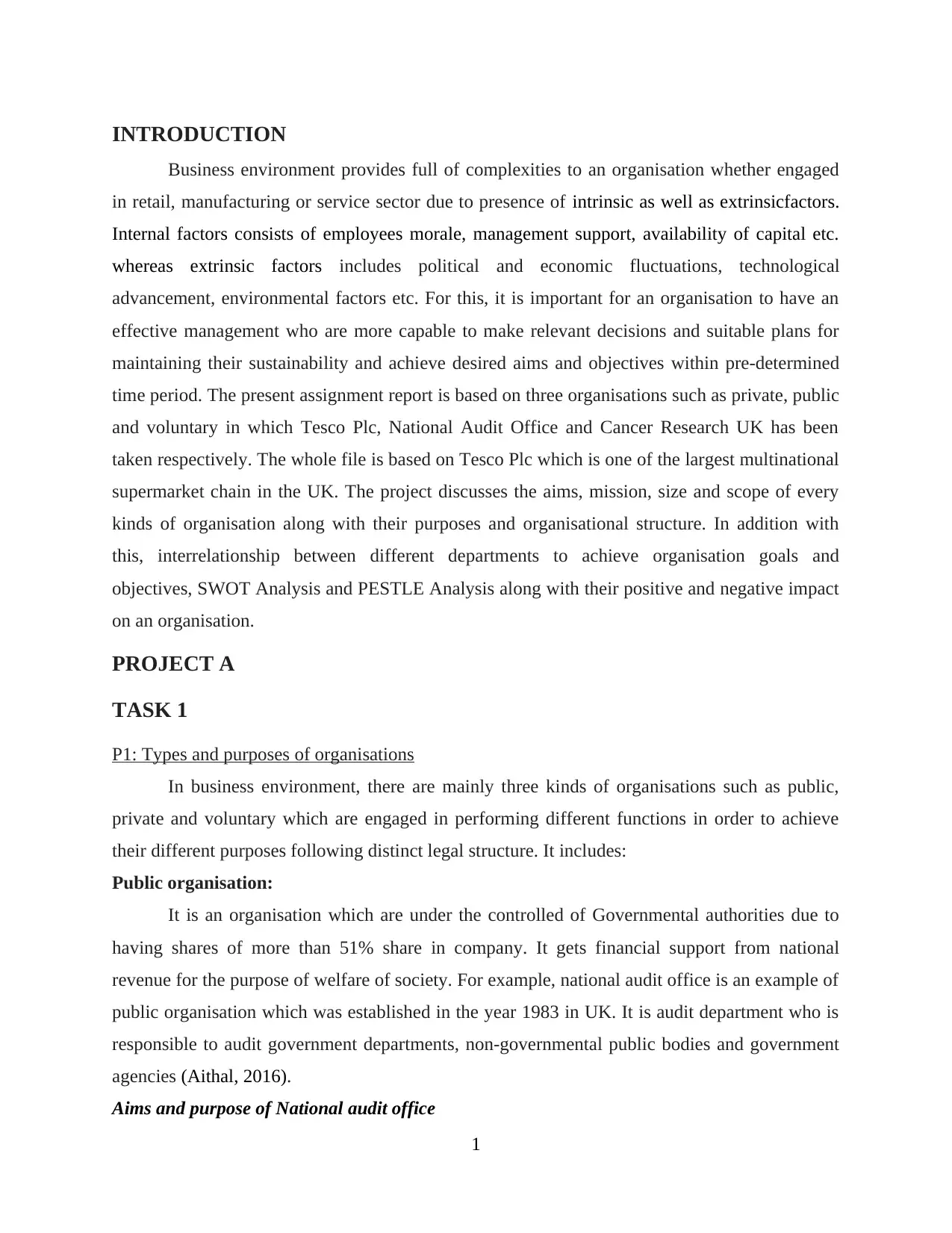
INTRODUCTION
Business environment provides full of complexities to an organisation whether engaged
in retail, manufacturing or service sector due to presence of intrinsic as well as extrinsicfactors.
Internal factors consists of employees morale, management support, availability of capital etc.
whereas extrinsic factors includes political and economic fluctuations, technological
advancement, environmental factors etc. For this, it is important for an organisation to have an
effective management who are more capable to make relevant decisions and suitable plans for
maintaining their sustainability and achieve desired aims and objectives within pre-determined
time period. The present assignment report is based on three organisations such as private, public
and voluntary in which Tesco Plc, National Audit Office and Cancer Research UK has been
taken respectively. The whole file is based on Tesco Plc which is one of the largest multinational
supermarket chain in the UK. The project discusses the aims, mission, size and scope of every
kinds of organisation along with their purposes and organisational structure. In addition with
this, interrelationship between different departments to achieve organisation goals and
objectives, SWOT Analysis and PESTLE Analysis along with their positive and negative impact
on an organisation.
PROJECT A
TASK 1
P1: Types and purposes of organisations
In business environment, there are mainly three kinds of organisations such as public,
private and voluntary which are engaged in performing different functions in order to achieve
their different purposes following distinct legal structure. It includes:
Public organisation:
It is an organisation which are under the controlled of Governmental authorities due to
having shares of more than 51% share in company. It gets financial support from national
revenue for the purpose of welfare of society. For example, national audit office is an example of
public organisation which was established in the year 1983 in UK. It is audit department who is
responsible to audit government departments, non-governmental public bodies and government
agencies (Aithal, 2016).
Aims and purpose of National audit office
1
Business environment provides full of complexities to an organisation whether engaged
in retail, manufacturing or service sector due to presence of intrinsic as well as extrinsicfactors.
Internal factors consists of employees morale, management support, availability of capital etc.
whereas extrinsic factors includes political and economic fluctuations, technological
advancement, environmental factors etc. For this, it is important for an organisation to have an
effective management who are more capable to make relevant decisions and suitable plans for
maintaining their sustainability and achieve desired aims and objectives within pre-determined
time period. The present assignment report is based on three organisations such as private, public
and voluntary in which Tesco Plc, National Audit Office and Cancer Research UK has been
taken respectively. The whole file is based on Tesco Plc which is one of the largest multinational
supermarket chain in the UK. The project discusses the aims, mission, size and scope of every
kinds of organisation along with their purposes and organisational structure. In addition with
this, interrelationship between different departments to achieve organisation goals and
objectives, SWOT Analysis and PESTLE Analysis along with their positive and negative impact
on an organisation.
PROJECT A
TASK 1
P1: Types and purposes of organisations
In business environment, there are mainly three kinds of organisations such as public,
private and voluntary which are engaged in performing different functions in order to achieve
their different purposes following distinct legal structure. It includes:
Public organisation:
It is an organisation which are under the controlled of Governmental authorities due to
having shares of more than 51% share in company. It gets financial support from national
revenue for the purpose of welfare of society. For example, national audit office is an example of
public organisation which was established in the year 1983 in UK. It is audit department who is
responsible to audit government departments, non-governmental public bodies and government
agencies (Aithal, 2016).
Aims and purpose of National audit office
1
Paraphrase This Document
Need a fresh take? Get an instant paraphrase of this document with our AI Paraphraser
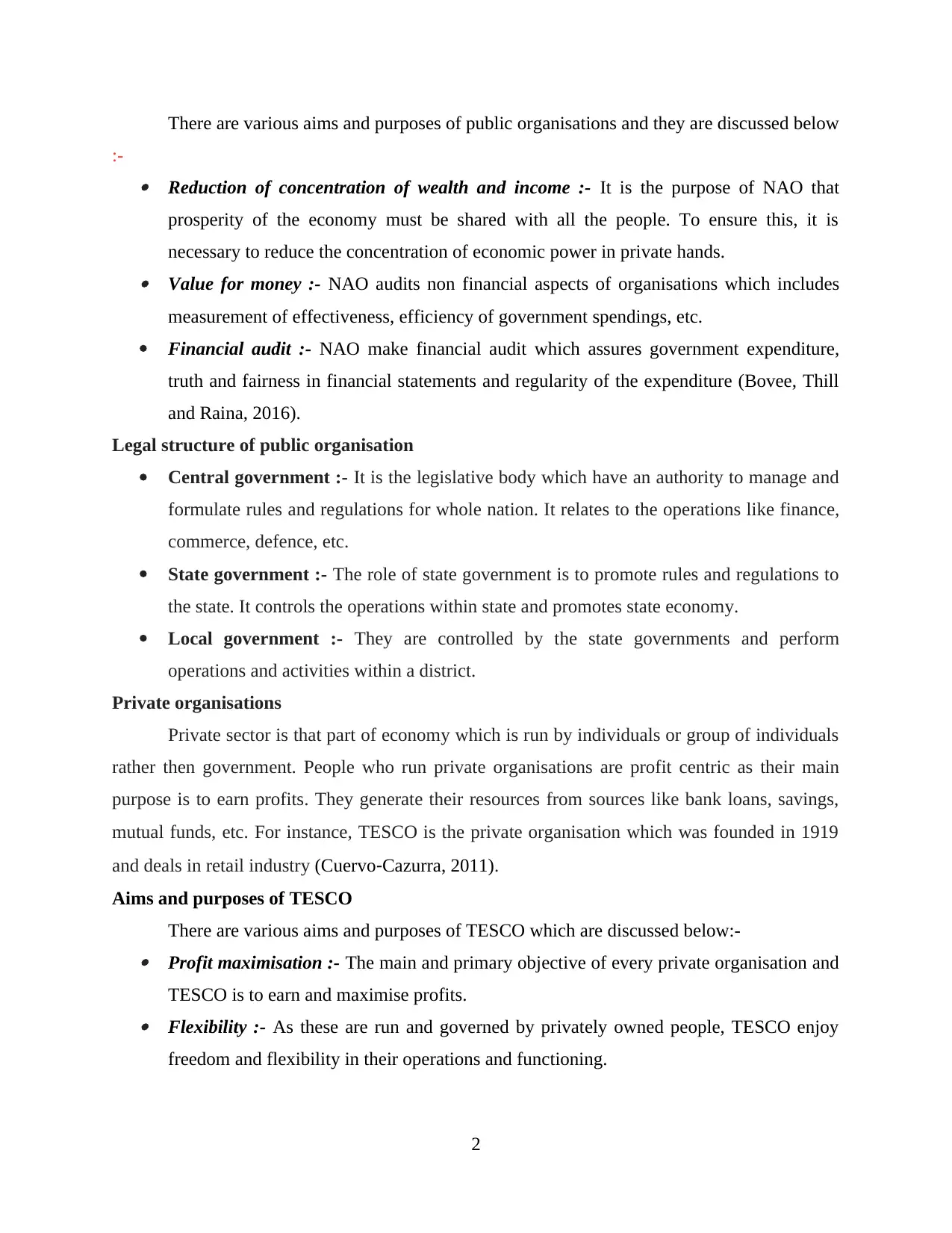
There are various aims and purposes of public organisations and they are discussed below
:- Reduction of concentration of wealth and income :- It is the purpose of NAO that
prosperity of the economy must be shared with all the people. To ensure this, it is
necessary to reduce the concentration of economic power in private hands. Value for money :- NAO audits non financial aspects of organisations which includes
measurement of effectiveness, efficiency of government spendings, etc.
Financial audit :- NAO make financial audit which assures government expenditure,
truth and fairness in financial statements and regularity of the expenditure (Bovee, Thill
and Raina, 2016).
Legal structure of public organisation
Central government :- It is the legislative body which have an authority to manage and
formulate rules and regulations for whole nation. It relates to the operations like finance,
commerce, defence, etc.
State government :- The role of state government is to promote rules and regulations to
the state. It controls the operations within state and promotes state economy.
Local government :- They are controlled by the state governments and perform
operations and activities within a district.
Private organisations
Private sector is that part of economy which is run by individuals or group of individuals
rather then government. People who run private organisations are profit centric as their main
purpose is to earn profits. They generate their resources from sources like bank loans, savings,
mutual funds, etc. For instance, TESCO is the private organisation which was founded in 1919
and deals in retail industry (Cuervo‐Cazurra, 2011).
Aims and purposes of TESCO
There are various aims and purposes of TESCO which are discussed below:- Profit maximisation :- The main and primary objective of every private organisation and
TESCO is to earn and maximise profits. Flexibility :- As these are run and governed by privately owned people, TESCO enjoy
freedom and flexibility in their operations and functioning.
2
:- Reduction of concentration of wealth and income :- It is the purpose of NAO that
prosperity of the economy must be shared with all the people. To ensure this, it is
necessary to reduce the concentration of economic power in private hands. Value for money :- NAO audits non financial aspects of organisations which includes
measurement of effectiveness, efficiency of government spendings, etc.
Financial audit :- NAO make financial audit which assures government expenditure,
truth and fairness in financial statements and regularity of the expenditure (Bovee, Thill
and Raina, 2016).
Legal structure of public organisation
Central government :- It is the legislative body which have an authority to manage and
formulate rules and regulations for whole nation. It relates to the operations like finance,
commerce, defence, etc.
State government :- The role of state government is to promote rules and regulations to
the state. It controls the operations within state and promotes state economy.
Local government :- They are controlled by the state governments and perform
operations and activities within a district.
Private organisations
Private sector is that part of economy which is run by individuals or group of individuals
rather then government. People who run private organisations are profit centric as their main
purpose is to earn profits. They generate their resources from sources like bank loans, savings,
mutual funds, etc. For instance, TESCO is the private organisation which was founded in 1919
and deals in retail industry (Cuervo‐Cazurra, 2011).
Aims and purposes of TESCO
There are various aims and purposes of TESCO which are discussed below:- Profit maximisation :- The main and primary objective of every private organisation and
TESCO is to earn and maximise profits. Flexibility :- As these are run and governed by privately owned people, TESCO enjoy
freedom and flexibility in their operations and functioning.
2
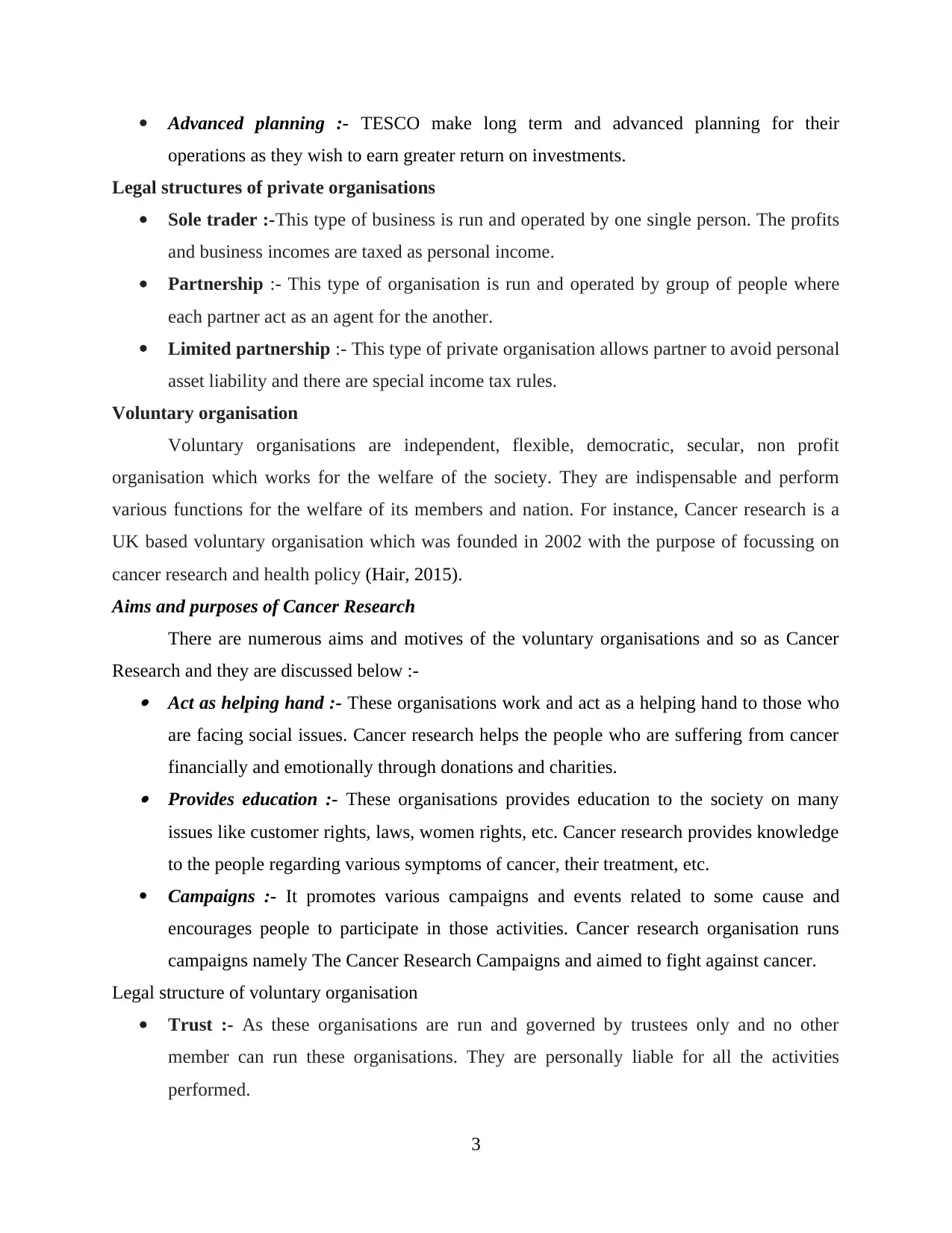
Advanced planning :- TESCO make long term and advanced planning for their
operations as they wish to earn greater return on investments.
Legal structures of private organisations
Sole trader :-This type of business is run and operated by one single person. The profits
and business incomes are taxed as personal income.
Partnership :- This type of organisation is run and operated by group of people where
each partner act as an agent for the another.
Limited partnership :- This type of private organisation allows partner to avoid personal
asset liability and there are special income tax rules.
Voluntary organisation
Voluntary organisations are independent, flexible, democratic, secular, non profit
organisation which works for the welfare of the society. They are indispensable and perform
various functions for the welfare of its members and nation. For instance, Cancer research is a
UK based voluntary organisation which was founded in 2002 with the purpose of focussing on
cancer research and health policy (Hair, 2015).
Aims and purposes of Cancer Research
There are numerous aims and motives of the voluntary organisations and so as Cancer
Research and they are discussed below :- Act as helping hand :- These organisations work and act as a helping hand to those who
are facing social issues. Cancer research helps the people who are suffering from cancer
financially and emotionally through donations and charities. Provides education :- These organisations provides education to the society on many
issues like customer rights, laws, women rights, etc. Cancer research provides knowledge
to the people regarding various symptoms of cancer, their treatment, etc.
Campaigns :- It promotes various campaigns and events related to some cause and
encourages people to participate in those activities. Cancer research organisation runs
campaigns namely The Cancer Research Campaigns and aimed to fight against cancer.
Legal structure of voluntary organisation
Trust :- As these organisations are run and governed by trustees only and no other
member can run these organisations. They are personally liable for all the activities
performed.
3
operations as they wish to earn greater return on investments.
Legal structures of private organisations
Sole trader :-This type of business is run and operated by one single person. The profits
and business incomes are taxed as personal income.
Partnership :- This type of organisation is run and operated by group of people where
each partner act as an agent for the another.
Limited partnership :- This type of private organisation allows partner to avoid personal
asset liability and there are special income tax rules.
Voluntary organisation
Voluntary organisations are independent, flexible, democratic, secular, non profit
organisation which works for the welfare of the society. They are indispensable and perform
various functions for the welfare of its members and nation. For instance, Cancer research is a
UK based voluntary organisation which was founded in 2002 with the purpose of focussing on
cancer research and health policy (Hair, 2015).
Aims and purposes of Cancer Research
There are numerous aims and motives of the voluntary organisations and so as Cancer
Research and they are discussed below :- Act as helping hand :- These organisations work and act as a helping hand to those who
are facing social issues. Cancer research helps the people who are suffering from cancer
financially and emotionally through donations and charities. Provides education :- These organisations provides education to the society on many
issues like customer rights, laws, women rights, etc. Cancer research provides knowledge
to the people regarding various symptoms of cancer, their treatment, etc.
Campaigns :- It promotes various campaigns and events related to some cause and
encourages people to participate in those activities. Cancer research organisation runs
campaigns namely The Cancer Research Campaigns and aimed to fight against cancer.
Legal structure of voluntary organisation
Trust :- As these organisations are run and governed by trustees only and no other
member can run these organisations. They are personally liable for all the activities
performed.
3
⊘ This is a preview!⊘
Do you want full access?
Subscribe today to unlock all pages.

Trusted by 1+ million students worldwide
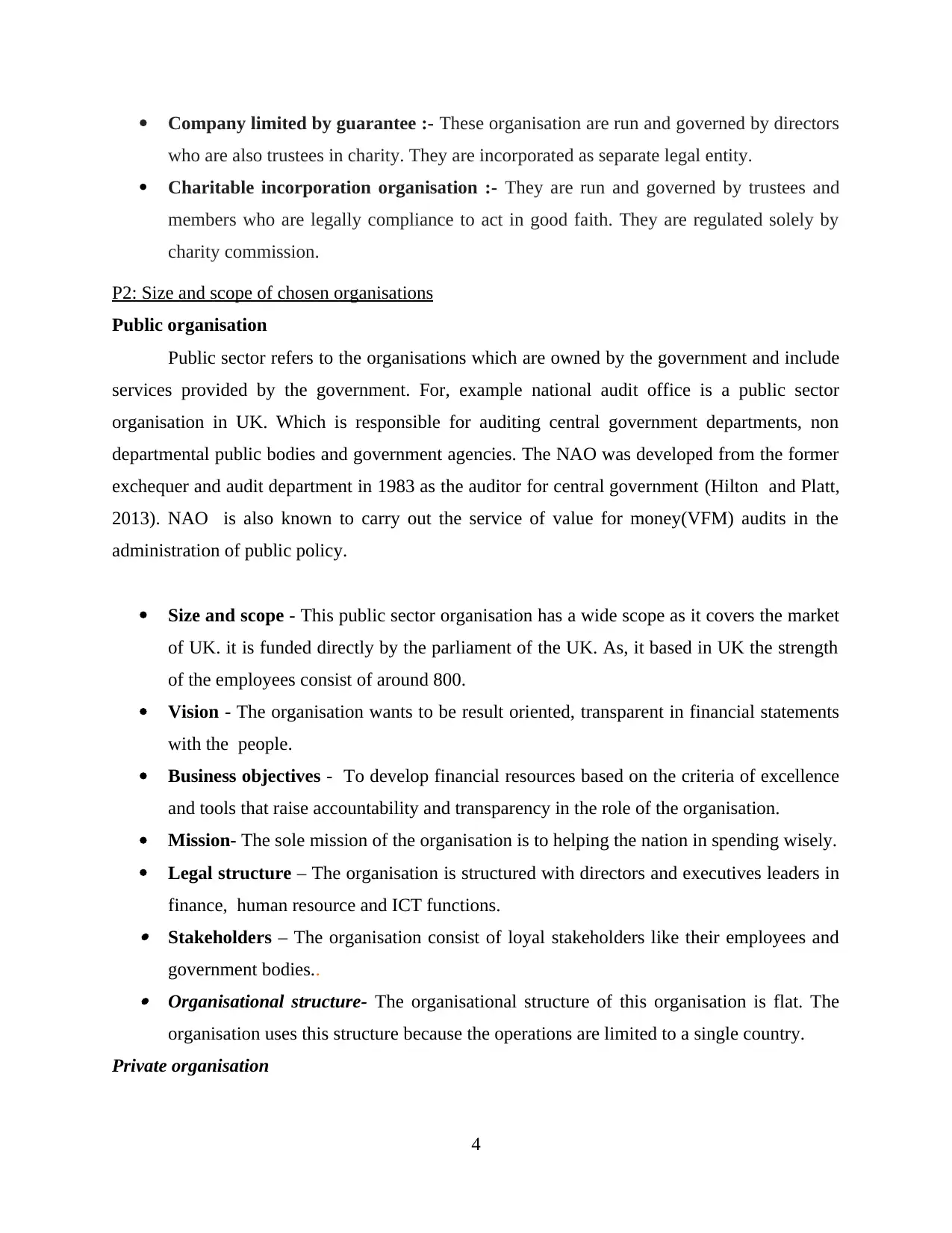
Company limited by guarantee :- These organisation are run and governed by directors
who are also trustees in charity. They are incorporated as separate legal entity.
Charitable incorporation organisation :- They are run and governed by trustees and
members who are legally compliance to act in good faith. They are regulated solely by
charity commission.
P2: Size and scope of chosen organisations
Public organisation
Public sector refers to the organisations which are owned by the government and include
services provided by the government. For, example national audit office is a public sector
organisation in UK. Which is responsible for auditing central government departments, non
departmental public bodies and government agencies. The NAO was developed from the former
exchequer and audit department in 1983 as the auditor for central government (Hilton and Platt,
2013). NAO is also known to carry out the service of value for money(VFM) audits in the
administration of public policy.
Size and scope - This public sector organisation has a wide scope as it covers the market
of UK. it is funded directly by the parliament of the UK. As, it based in UK the strength
of the employees consist of around 800.
Vision - The organisation wants to be result oriented, transparent in financial statements
with the people.
Business objectives - To develop financial resources based on the criteria of excellence
and tools that raise accountability and transparency in the role of the organisation.
Mission- The sole mission of the organisation is to helping the nation in spending wisely.
Legal structure – The organisation is structured with directors and executives leaders in
finance, human resource and ICT functions. Stakeholders – The organisation consist of loyal stakeholders like their employees and
government bodies.. Organisational structure- The organisational structure of this organisation is flat. The
organisation uses this structure because the operations are limited to a single country.
Private organisation
4
who are also trustees in charity. They are incorporated as separate legal entity.
Charitable incorporation organisation :- They are run and governed by trustees and
members who are legally compliance to act in good faith. They are regulated solely by
charity commission.
P2: Size and scope of chosen organisations
Public organisation
Public sector refers to the organisations which are owned by the government and include
services provided by the government. For, example national audit office is a public sector
organisation in UK. Which is responsible for auditing central government departments, non
departmental public bodies and government agencies. The NAO was developed from the former
exchequer and audit department in 1983 as the auditor for central government (Hilton and Platt,
2013). NAO is also known to carry out the service of value for money(VFM) audits in the
administration of public policy.
Size and scope - This public sector organisation has a wide scope as it covers the market
of UK. it is funded directly by the parliament of the UK. As, it based in UK the strength
of the employees consist of around 800.
Vision - The organisation wants to be result oriented, transparent in financial statements
with the people.
Business objectives - To develop financial resources based on the criteria of excellence
and tools that raise accountability and transparency in the role of the organisation.
Mission- The sole mission of the organisation is to helping the nation in spending wisely.
Legal structure – The organisation is structured with directors and executives leaders in
finance, human resource and ICT functions. Stakeholders – The organisation consist of loyal stakeholders like their employees and
government bodies.. Organisational structure- The organisational structure of this organisation is flat. The
organisation uses this structure because the operations are limited to a single country.
Private organisation
4
Paraphrase This Document
Need a fresh take? Get an instant paraphrase of this document with our AI Paraphraser
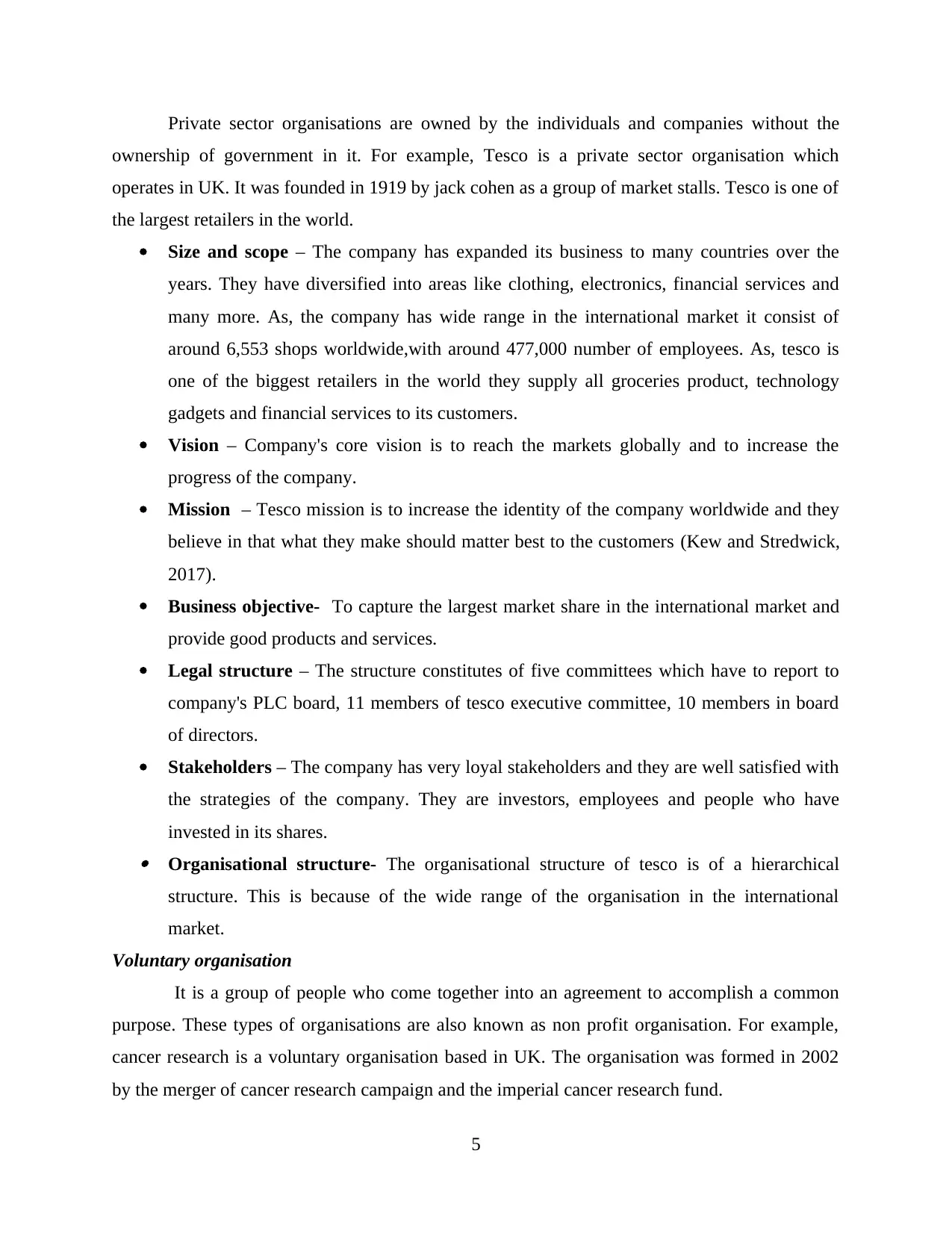
Private sector organisations are owned by the individuals and companies without the
ownership of government in it. For example, Tesco is a private sector organisation which
operates in UK. It was founded in 1919 by jack cohen as a group of market stalls. Tesco is one of
the largest retailers in the world.
Size and scope – The company has expanded its business to many countries over the
years. They have diversified into areas like clothing, electronics, financial services and
many more. As, the company has wide range in the international market it consist of
around 6,553 shops worldwide,with around 477,000 number of employees. As, tesco is
one of the biggest retailers in the world they supply all groceries product, technology
gadgets and financial services to its customers.
Vision – Company's core vision is to reach the markets globally and to increase the
progress of the company.
Mission – Tesco mission is to increase the identity of the company worldwide and they
believe in that what they make should matter best to the customers (Kew and Stredwick,
2017).
Business objective- To capture the largest market share in the international market and
provide good products and services.
Legal structure – The structure constitutes of five committees which have to report to
company's PLC board, 11 members of tesco executive committee, 10 members in board
of directors.
Stakeholders – The company has very loyal stakeholders and they are well satisfied with
the strategies of the company. They are investors, employees and people who have
invested in its shares. Organisational structure- The organisational structure of tesco is of a hierarchical
structure. This is because of the wide range of the organisation in the international
market.
Voluntary organisation
It is a group of people who come together into an agreement to accomplish a common
purpose. These types of organisations are also known as non profit organisation. For example,
cancer research is a voluntary organisation based in UK. The organisation was formed in 2002
by the merger of cancer research campaign and the imperial cancer research fund.
5
ownership of government in it. For example, Tesco is a private sector organisation which
operates in UK. It was founded in 1919 by jack cohen as a group of market stalls. Tesco is one of
the largest retailers in the world.
Size and scope – The company has expanded its business to many countries over the
years. They have diversified into areas like clothing, electronics, financial services and
many more. As, the company has wide range in the international market it consist of
around 6,553 shops worldwide,with around 477,000 number of employees. As, tesco is
one of the biggest retailers in the world they supply all groceries product, technology
gadgets and financial services to its customers.
Vision – Company's core vision is to reach the markets globally and to increase the
progress of the company.
Mission – Tesco mission is to increase the identity of the company worldwide and they
believe in that what they make should matter best to the customers (Kew and Stredwick,
2017).
Business objective- To capture the largest market share in the international market and
provide good products and services.
Legal structure – The structure constitutes of five committees which have to report to
company's PLC board, 11 members of tesco executive committee, 10 members in board
of directors.
Stakeholders – The company has very loyal stakeholders and they are well satisfied with
the strategies of the company. They are investors, employees and people who have
invested in its shares. Organisational structure- The organisational structure of tesco is of a hierarchical
structure. This is because of the wide range of the organisation in the international
market.
Voluntary organisation
It is a group of people who come together into an agreement to accomplish a common
purpose. These types of organisations are also known as non profit organisation. For example,
cancer research is a voluntary organisation based in UK. The organisation was formed in 2002
by the merger of cancer research campaign and the imperial cancer research fund.
5
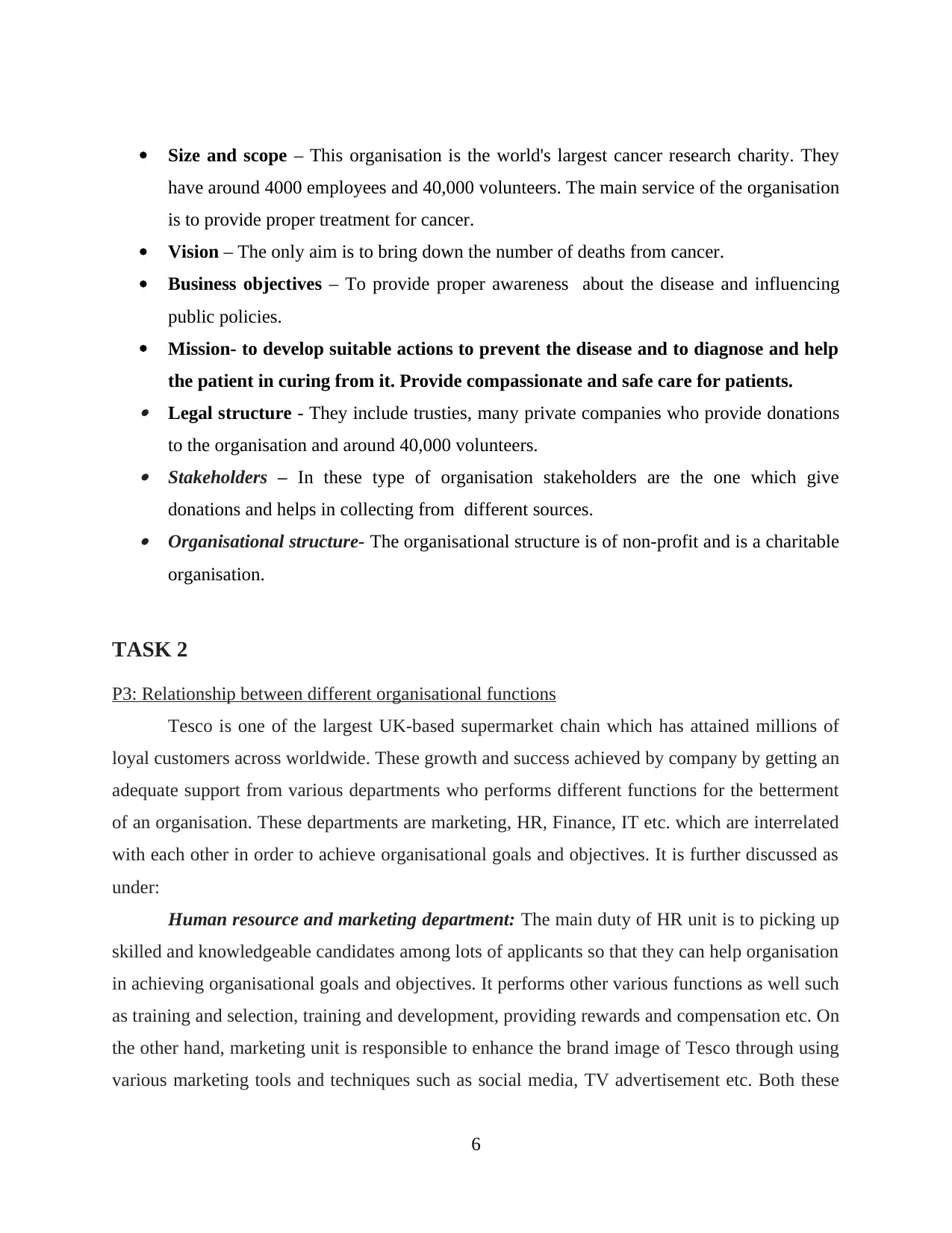
Size and scope – This organisation is the world's largest cancer research charity. They
have around 4000 employees and 40,000 volunteers. The main service of the organisation
is to provide proper treatment for cancer.
Vision – The only aim is to bring down the number of deaths from cancer.
Business objectives – To provide proper awareness about the disease and influencing
public policies.
Mission- to develop suitable actions to prevent the disease and to diagnose and help
the patient in curing from it. Provide compassionate and safe care for patients. Legal structure - They include trusties, many private companies who provide donations
to the organisation and around 40,000 volunteers. Stakeholders – In these type of organisation stakeholders are the one which give
donations and helps in collecting from different sources. Organisational structure- The organisational structure is of non-profit and is a charitable
organisation.
TASK 2
P3: Relationship between different organisational functions
Tesco is one of the largest UK-based supermarket chain which has attained millions of
loyal customers across worldwide. These growth and success achieved by company by getting an
adequate support from various departments who performs different functions for the betterment
of an organisation. These departments are marketing, HR, Finance, IT etc. which are interrelated
with each other in order to achieve organisational goals and objectives. It is further discussed as
under:
Human resource and marketing department: The main duty of HR unit is to picking up
skilled and knowledgeable candidates among lots of applicants so that they can help organisation
in achieving organisational goals and objectives. It performs other various functions as well such
as training and selection, training and development, providing rewards and compensation etc. On
the other hand, marketing unit is responsible to enhance the brand image of Tesco through using
various marketing tools and techniques such as social media, TV advertisement etc. Both these
6
have around 4000 employees and 40,000 volunteers. The main service of the organisation
is to provide proper treatment for cancer.
Vision – The only aim is to bring down the number of deaths from cancer.
Business objectives – To provide proper awareness about the disease and influencing
public policies.
Mission- to develop suitable actions to prevent the disease and to diagnose and help
the patient in curing from it. Provide compassionate and safe care for patients. Legal structure - They include trusties, many private companies who provide donations
to the organisation and around 40,000 volunteers. Stakeholders – In these type of organisation stakeholders are the one which give
donations and helps in collecting from different sources. Organisational structure- The organisational structure is of non-profit and is a charitable
organisation.
TASK 2
P3: Relationship between different organisational functions
Tesco is one of the largest UK-based supermarket chain which has attained millions of
loyal customers across worldwide. These growth and success achieved by company by getting an
adequate support from various departments who performs different functions for the betterment
of an organisation. These departments are marketing, HR, Finance, IT etc. which are interrelated
with each other in order to achieve organisational goals and objectives. It is further discussed as
under:
Human resource and marketing department: The main duty of HR unit is to picking up
skilled and knowledgeable candidates among lots of applicants so that they can help organisation
in achieving organisational goals and objectives. It performs other various functions as well such
as training and selection, training and development, providing rewards and compensation etc. On
the other hand, marketing unit is responsible to enhance the brand image of Tesco through using
various marketing tools and techniques such as social media, TV advertisement etc. Both these
6
⊘ This is a preview!⊘
Do you want full access?
Subscribe today to unlock all pages.

Trusted by 1+ million students worldwide
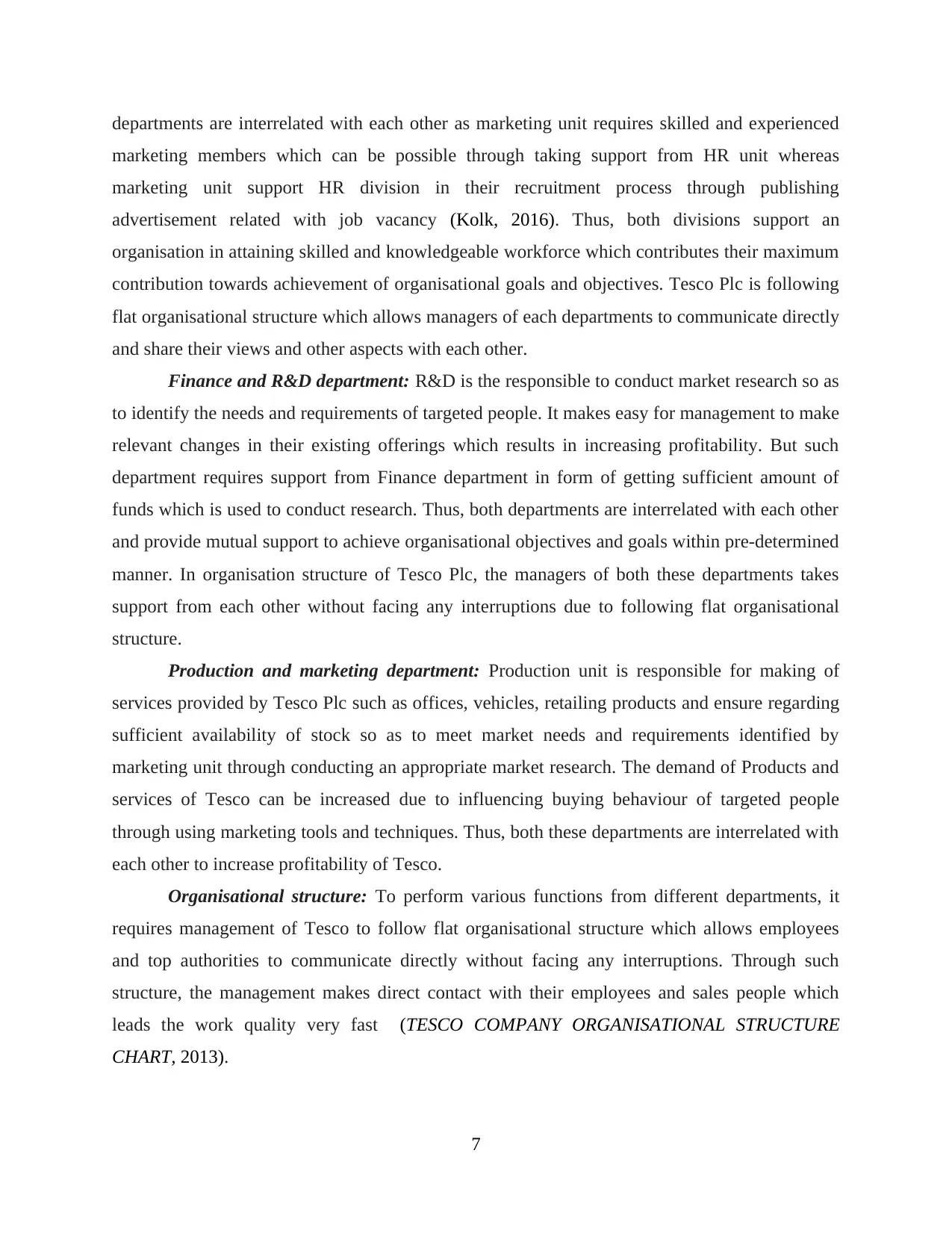
departments are interrelated with each other as marketing unit requires skilled and experienced
marketing members which can be possible through taking support from HR unit whereas
marketing unit support HR division in their recruitment process through publishing
advertisement related with job vacancy (Kolk, 2016). Thus, both divisions support an
organisation in attaining skilled and knowledgeable workforce which contributes their maximum
contribution towards achievement of organisational goals and objectives. Tesco Plc is following
flat organisational structure which allows managers of each departments to communicate directly
and share their views and other aspects with each other.
Finance and R&D department: R&D is the responsible to conduct market research so as
to identify the needs and requirements of targeted people. It makes easy for management to make
relevant changes in their existing offerings which results in increasing profitability. But such
department requires support from Finance department in form of getting sufficient amount of
funds which is used to conduct research. Thus, both departments are interrelated with each other
and provide mutual support to achieve organisational objectives and goals within pre-determined
manner. In organisation structure of Tesco Plc, the managers of both these departments takes
support from each other without facing any interruptions due to following flat organisational
structure.
Production and marketing department: Production unit is responsible for making of
services provided by Tesco Plc such as offices, vehicles, retailing products and ensure regarding
sufficient availability of stock so as to meet market needs and requirements identified by
marketing unit through conducting an appropriate market research. The demand of Products and
services of Tesco can be increased due to influencing buying behaviour of targeted people
through using marketing tools and techniques. Thus, both these departments are interrelated with
each other to increase profitability of Tesco.
Organisational structure: To perform various functions from different departments, it
requires management of Tesco to follow flat organisational structure which allows employees
and top authorities to communicate directly without facing any interruptions. Through such
structure, the management makes direct contact with their employees and sales people which
leads the work quality very fast (TESCO COMPANY ORGANISATIONAL STRUCTURE
CHART, 2013).
7
marketing members which can be possible through taking support from HR unit whereas
marketing unit support HR division in their recruitment process through publishing
advertisement related with job vacancy (Kolk, 2016). Thus, both divisions support an
organisation in attaining skilled and knowledgeable workforce which contributes their maximum
contribution towards achievement of organisational goals and objectives. Tesco Plc is following
flat organisational structure which allows managers of each departments to communicate directly
and share their views and other aspects with each other.
Finance and R&D department: R&D is the responsible to conduct market research so as
to identify the needs and requirements of targeted people. It makes easy for management to make
relevant changes in their existing offerings which results in increasing profitability. But such
department requires support from Finance department in form of getting sufficient amount of
funds which is used to conduct research. Thus, both departments are interrelated with each other
and provide mutual support to achieve organisational objectives and goals within pre-determined
manner. In organisation structure of Tesco Plc, the managers of both these departments takes
support from each other without facing any interruptions due to following flat organisational
structure.
Production and marketing department: Production unit is responsible for making of
services provided by Tesco Plc such as offices, vehicles, retailing products and ensure regarding
sufficient availability of stock so as to meet market needs and requirements identified by
marketing unit through conducting an appropriate market research. The demand of Products and
services of Tesco can be increased due to influencing buying behaviour of targeted people
through using marketing tools and techniques. Thus, both these departments are interrelated with
each other to increase profitability of Tesco.
Organisational structure: To perform various functions from different departments, it
requires management of Tesco to follow flat organisational structure which allows employees
and top authorities to communicate directly without facing any interruptions. Through such
structure, the management makes direct contact with their employees and sales people which
leads the work quality very fast (TESCO COMPANY ORGANISATIONAL STRUCTURE
CHART, 2013).
7
Paraphrase This Document
Need a fresh take? Get an instant paraphrase of this document with our AI Paraphraser
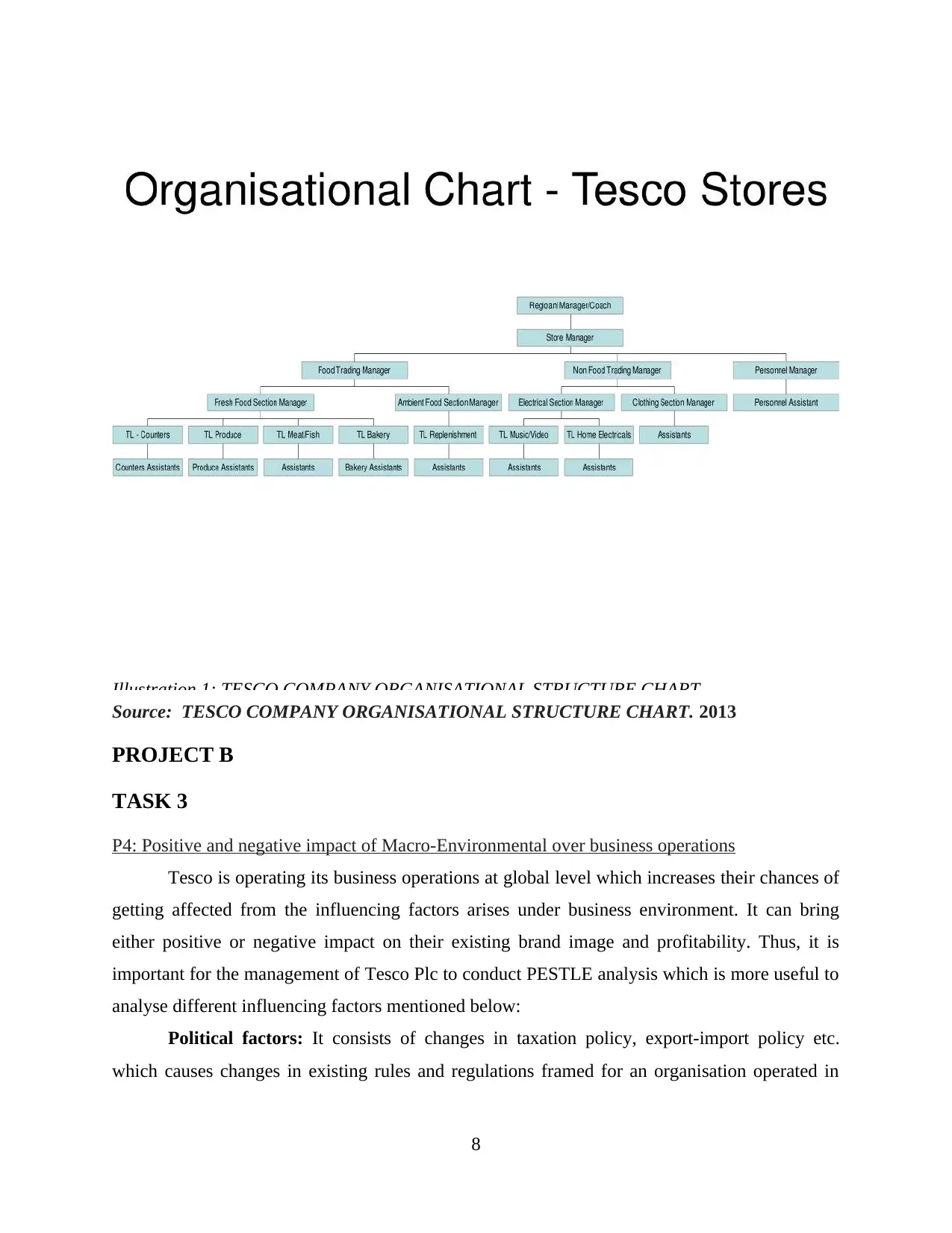
Illustration 1: TESCO COMPANY ORGANISATIONAL STRUCTURE CHART
Source: TESCO COMPANY ORGANISATIONAL STRUCTURE CHART. 2013
PROJECT B
TASK 3
P4: Positive and negative impact of Macro-Environmental over business operations
Tesco is operating its business operations at global level which increases their chances of
getting affected from the influencing factors arises under business environment. It can bring
either positive or negative impact on their existing brand image and profitability. Thus, it is
important for the management of Tesco Plc to conduct PESTLE analysis which is more useful to
analyse different influencing factors mentioned below:
Political factors: It consists of changes in taxation policy, export-import policy etc.
which causes changes in existing rules and regulations framed for an organisation operated in
8
Source: TESCO COMPANY ORGANISATIONAL STRUCTURE CHART. 2013
PROJECT B
TASK 3
P4: Positive and negative impact of Macro-Environmental over business operations
Tesco is operating its business operations at global level which increases their chances of
getting affected from the influencing factors arises under business environment. It can bring
either positive or negative impact on their existing brand image and profitability. Thus, it is
important for the management of Tesco Plc to conduct PESTLE analysis which is more useful to
analyse different influencing factors mentioned below:
Political factors: It consists of changes in taxation policy, export-import policy etc.
which causes changes in existing rules and regulations framed for an organisation operated in
8
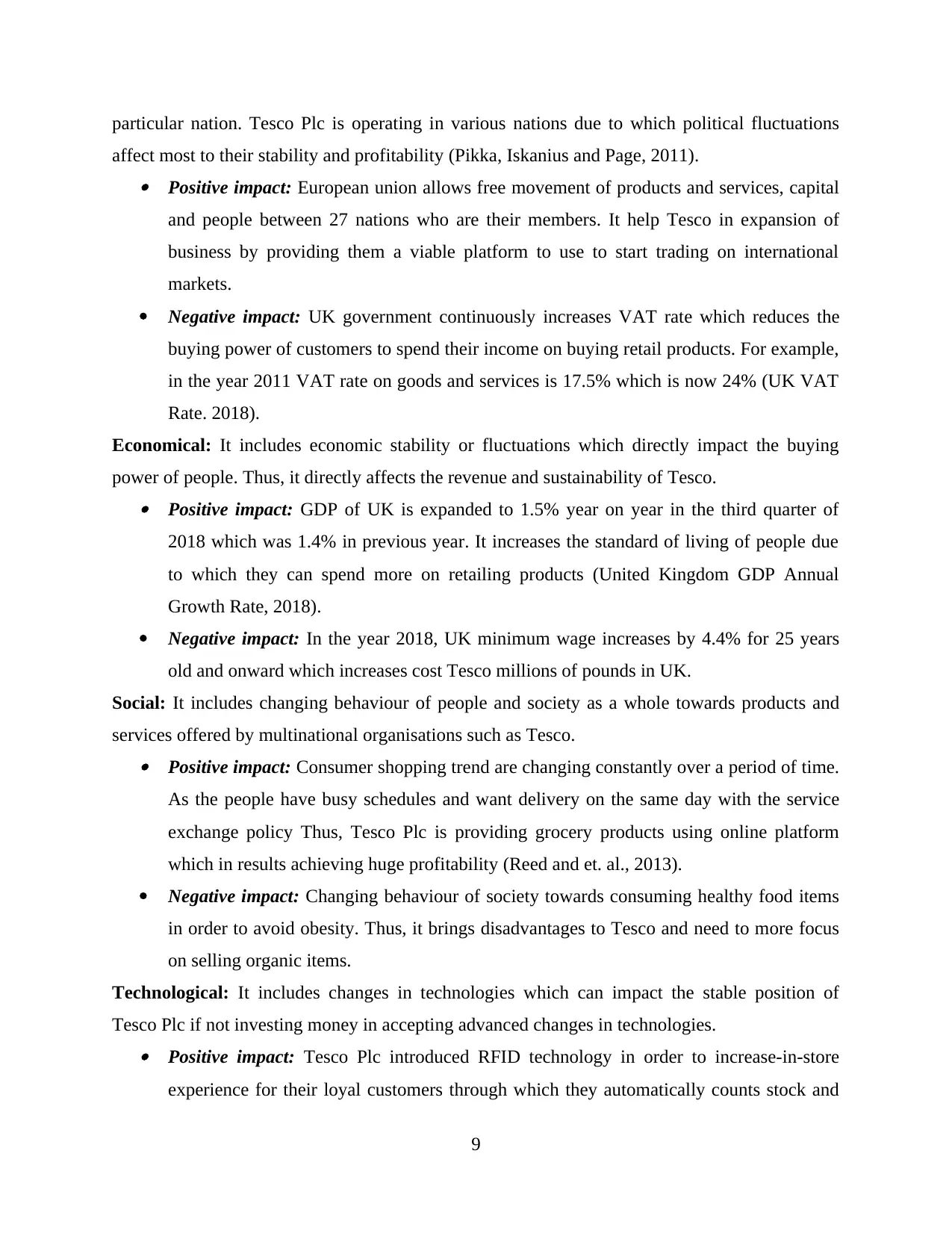
particular nation. Tesco Plc is operating in various nations due to which political fluctuations
affect most to their stability and profitability (Pikka, Iskanius and Page, 2011). Positive impact: European union allows free movement of products and services, capital
and people between 27 nations who are their members. It help Tesco in expansion of
business by providing them a viable platform to use to start trading on international
markets.
Negative impact: UK government continuously increases VAT rate which reduces the
buying power of customers to spend their income on buying retail products. For example,
in the year 2011 VAT rate on goods and services is 17.5% which is now 24% (UK VAT
Rate. 2018).
Economical: It includes economic stability or fluctuations which directly impact the buying
power of people. Thus, it directly affects the revenue and sustainability of Tesco. Positive impact: GDP of UK is expanded to 1.5% year on year in the third quarter of
2018 which was 1.4% in previous year. It increases the standard of living of people due
to which they can spend more on retailing products (United Kingdom GDP Annual
Growth Rate, 2018).
Negative impact: In the year 2018, UK minimum wage increases by 4.4% for 25 years
old and onward which increases cost Tesco millions of pounds in UK.
Social: It includes changing behaviour of people and society as a whole towards products and
services offered by multinational organisations such as Tesco. Positive impact: Consumer shopping trend are changing constantly over a period of time.
As the people have busy schedules and want delivery on the same day with the service
exchange policy Thus, Tesco Plc is providing grocery products using online platform
which in results achieving huge profitability (Reed and et. al., 2013).
Negative impact: Changing behaviour of society towards consuming healthy food items
in order to avoid obesity. Thus, it brings disadvantages to Tesco and need to more focus
on selling organic items.
Technological: It includes changes in technologies which can impact the stable position of
Tesco Plc if not investing money in accepting advanced changes in technologies. Positive impact: Tesco Plc introduced RFID technology in order to increase-in-store
experience for their loyal customers through which they automatically counts stock and
9
affect most to their stability and profitability (Pikka, Iskanius and Page, 2011). Positive impact: European union allows free movement of products and services, capital
and people between 27 nations who are their members. It help Tesco in expansion of
business by providing them a viable platform to use to start trading on international
markets.
Negative impact: UK government continuously increases VAT rate which reduces the
buying power of customers to spend their income on buying retail products. For example,
in the year 2011 VAT rate on goods and services is 17.5% which is now 24% (UK VAT
Rate. 2018).
Economical: It includes economic stability or fluctuations which directly impact the buying
power of people. Thus, it directly affects the revenue and sustainability of Tesco. Positive impact: GDP of UK is expanded to 1.5% year on year in the third quarter of
2018 which was 1.4% in previous year. It increases the standard of living of people due
to which they can spend more on retailing products (United Kingdom GDP Annual
Growth Rate, 2018).
Negative impact: In the year 2018, UK minimum wage increases by 4.4% for 25 years
old and onward which increases cost Tesco millions of pounds in UK.
Social: It includes changing behaviour of people and society as a whole towards products and
services offered by multinational organisations such as Tesco. Positive impact: Consumer shopping trend are changing constantly over a period of time.
As the people have busy schedules and want delivery on the same day with the service
exchange policy Thus, Tesco Plc is providing grocery products using online platform
which in results achieving huge profitability (Reed and et. al., 2013).
Negative impact: Changing behaviour of society towards consuming healthy food items
in order to avoid obesity. Thus, it brings disadvantages to Tesco and need to more focus
on selling organic items.
Technological: It includes changes in technologies which can impact the stable position of
Tesco Plc if not investing money in accepting advanced changes in technologies. Positive impact: Tesco Plc introduced RFID technology in order to increase-in-store
experience for their loyal customers through which they automatically counts stock and
9
⊘ This is a preview!⊘
Do you want full access?
Subscribe today to unlock all pages.

Trusted by 1+ million students worldwide
1 out of 24
Related Documents
Your All-in-One AI-Powered Toolkit for Academic Success.
+13062052269
info@desklib.com
Available 24*7 on WhatsApp / Email
![[object Object]](/_next/static/media/star-bottom.7253800d.svg)
Unlock your academic potential
Copyright © 2020–2025 A2Z Services. All Rights Reserved. Developed and managed by ZUCOL.





